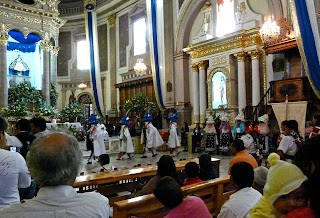
I will now try to explore in a small way the the symbolism of the Moors and the danza de los Moros. On December 7, the day before the Fiesta de la Salud, a relatively new group of Moor dancers performed in front of the alter of the Basilica. This year the dance group consisted of 4 men and 4 women (las Moras), each group in slightly different costume. While it is interesting that women were performing in this dance (the first time I have seen this) they did not perform together but as two groups. The group was accompanied by their traditional band and four horses. They gathered outside the Basilica and when ready the priest came to the door, blessed everyone and welcomed them into the church. The female dancers and then the male dancers performed in front of the alter and before a reasonable crowd. The dancers were introduced by the priest and supported as carrying on an ancient tradition. I believe this tradition represents the indigenous acceptance of Christianity and subservience to the new God. I wonder if the dancers or the audience associate the dance with Muslims or infidels or if it has just become the traditional dance of the region in praise of God and church. What do Muslims think of this dance? The inquisition was applied primarily to Muslims and Jews and then the emerging Protestants. Does any of this enter the minds of those in the Basilica?
On completing the dance the male dancers mount their horses and with the women walking in front begin a parade through the pueblo, terminating at the presidencia (the office of the mayor and officialdom). Here they are greeted by the mayor and an array of bureaucrats. The organizer of the dance then offers a glass of tequila to the authorities, a traditional male gift giving. The dance is performed before the mayor and gathered crowd. Then the torito dancers perform and at one point the mayor and then bureaucrat are invited to perform, first as the bull and then the teaser.
I may be making too much of this but we have seen the indigenous peoples presenting themselves to and dancing for the two primary structures of power in the community - church and state. The church that surpressed their ancient religion and worked hard to bring them into the state sponsored religion of the Spanish. The state that seized their land and rather quickly transformed their way of life and challenged their historic structures of power. Most have been left in a marginal state and clinging to some traditional ways, having incorporated religious beliefs and events into their ancient traditions.
So what is the dance about? The criticisms of Cortes and even Christopher Columbus have been put aside for the day, and at the invitation of the church and the state, they show their subservience and at the same time display some of their unique cultural style and color.
See next post.
No comments:
Post a Comment